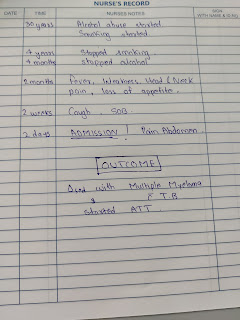2nd Bimonthly internal assessment
CASE1
Q1 Reason for this patients ascites
The most common cause of Ascites is
Cirrhosis of liver
risk factors in this patient :
1. Chronic alcoholism since 40 years
2. Truncal obesity
https://www.ncbi.nlm.nih.gov/pmc/articles/PMC6092576/
Regular alcohol abuse causing cirrhosis causes portal hypertension leading to increased hydrostatic pressure causing fluid accumulation hence Ascites
Q2
Bilateral pedal oedema which is of pitting type is due to decrease in the albumin level trends due to course of the disease and long standing cirrhosis causing decrease in the production of proteins causing decrease in the oncotic pressure leading to accumulation of fluid.
Ulcerations are due his limited self practising manoeuvres done in inappropriate conditions such as :
improper dressing of the wound, not maintaining aseptic conditions , indescriminate use of steroids (self medication) and immune suppression leading to secondary infections hence cellulitis and non healing of wound.
Q3
Reason for Asterexis and constructional apraxia
Asterixis is a clinical sign that describes the inability to maintain sustained posture with subsequent brief, shock-like, involuntary movements. This motor disorder is myoclonus characterized by muscular inhibition (whereas muscle contractions produce positive myoclonus)
this is due to...
role of neurotoxins and
impaired neurotransmission due to metabolic changes in liver failure, changes in brain energy metabolism, systemic inflammatory response and alterations of the blood brain barrier which produces a wide spectrum of nonspecific neurological and psychiatric manifestations.
https://www.ncbi.nlm.nih.gov/pmc/articles/PMC5421503/
Q4
treatment:
lactulose and rifaximin
why lactulose??
metabolism of sugars causes a laxative effect via an increase in intraluminal gas formation and osmolality which leads to a reduction in transit time and intraluminal pH. This laxative effect is also beneficial for constipation.[7]
OR
lactulose promotes increased uptake of ammonia by colonic bacteria which utilize the trapped colonic ammonia as a nitrogen source for protein synthesis. The reduction of intestinal pH facilitates this process, which favors the conversion of ammonia (NH3) produced by the gut bacteria, to ammonium an ionized form of the molecule, unable to cross biological membranes.
Treatment?
high protein diet (2eggs / day) for decreased albumin synthesis
fluid restriction and salt restriction for controlling hypertension combined with diuretic therapy makes sense.
CASE 3
1. As per the available clinical data nephrotic syndrome have been established
1.Initial management should focus on investigating the cause,
Primary ( idiopathic )
Secondary glomerular pathology
Primary causes include
FSGS
membranous glomerular nephropathy
minimal change
MPGN
https://www.ncbi.nlm.nih.gov/pmc/articles/PMC2394708/
Secondary causes of nephrotic syndrome
Other diseases
* Diabetes mellitus
* Systemic lupus erythematosus
* Amyloidosis
Cancer
* Myeloma and lymphoma
Drugs
* Gold
* Antimicrobial agents
* Non-steroidal anti-inflammatory drugs
* Penicillamine
* Captopril
* Tamoxifen
* Lithium
Infections
* HIV
* Hepatitis B and C
* Mycoplasma
* Syphilis
* Malaria
* Schistosomiasis
* Filariasis
* Toxoplasmosis
Congenital causes
* Alport’s syndrome
* Congenital nephrotic syndrome of the Finnish type
* Pierson’s syndrome
* Nail-patella syndrome
* Denys-Drash syndrome
https://www.ncbi.nlm.nih.gov/pmc/articles/PMC2394708/
2. Identifying complications such as
thromboembolism
Infections
hyperlipidemia
acute renal failure
3. Managing the symptoms of the disease such as protein loss, pedal oedema,
and hyper coagulable state which still did not manifested in this patient or need not be in many
cases.
Low dose steroids as initial management which also rules out steroid resistant nephrotic syndrome in future course of treatment, and slowly taper according to the need.
PROS: renal biopsy would be helpful in establishing the cause of which type of glomerular pathology is causing the nephrotic syndrome. however if the nephrotic syndrome is secondary to other above mentioned cases ruling out that gives a better picture rather than going straight away for biopsy .
CONS: Any invasive procedure has its pain and suffering. adding to it is the cose of the procedure!
CASE 2
Q1 May be ATT were stopped because of his concomitant Chronic liver disease secondary to ? chronic alcoholism as, the ATT first line drugs such as isoniazid and rifampicin are hepatic toxic
LFT is deranged
TB raised
ALP raised
low serum albumin ( synthesis is affected ).
history of watery diarrhoea since 20 days might be due to ?GI infection or
?Rifampicin induced (pseudomembranous colitis) was noticed although not specific to usage of rifampicin.
https://www.ncbi.nlm.nih.gov/pmc/articles/PMC3363060/
Usage of ATT induced hepatotoxicity increased 14-fold in patients with chronic liver diseases (CLD) and liver cirrhosis, more so in those with decompensated disease, probably due to the cirrhosis-associated immune dysfunction syndrome, and case-fatality rates are high.
If hepatotoxicity develops in those with liver cirrhosis, particularly decompensated cirrhosis, the risk of severe liver failure is markedly increased.
Treatment regimens of anti-tuberculosis therapy in patient with chronic alcoholic problem with only two potentially hepatotoxic drug:
(i) Regimens without INH
(ii) Regimens without PZA
B. Regimens with only one potentially hepatotoxic drug.
C. Regimens with no potentially hepatotoxic drugs.
https://www.ncbi.nlm.nih.gov/pmc/articles/PMC3940527/
Q2.
Bilateral Infiltrations of lung fields noted in CXR PA view
consolidations
?cavitiy in right lung.
Q3.
Chronic decompensated liver disease leading to ?portal hypertension
as the tap was transudative based on Lights criteria
Q4.Inj Human Actrapid Insulin s/c 8am - 2pm - 8pm for diabetic management
Inj PAN 40 mg IV/OD
Inj optineuron 1 amp in 100 ml NS Iv/bd for nutritional supplementation such as Vit B12
ATT to be with held for hepatoxicity although should be used based on CPT score mentioned above
Syp lactulose 15ml HS to prevent hepatic encephalopathy
Protein powder 3 to 4 scoops in 1 glass of milk or water QID for protein supplementation
Stop all OHA s
Grbs charting 6th hrly
Strict I/0 charting
High protein diet 4eggs daily for protein supplementation
ORS sachets in 1 litre of water to compensate electrolytes lost due to diarrhoea
Bp charting hourly
Inj PIPTAZ 4.5gm/IV/bd stat - - --> TID
Vit k 10 mg Iv OD for 5 days to prevent forthcoming ?bleeding manifestations
Temp BP PR monitoring 4th hourly
IVF - 1 DNS @50ml/hr for hydration
Nebulisation with salbutamol and mucomist 12th hourly. for ?cough
Inj thiamine 100 mg in 100 ml NS IV TID. for chronic alcoholism
.jpeg)

Comments
Post a Comment